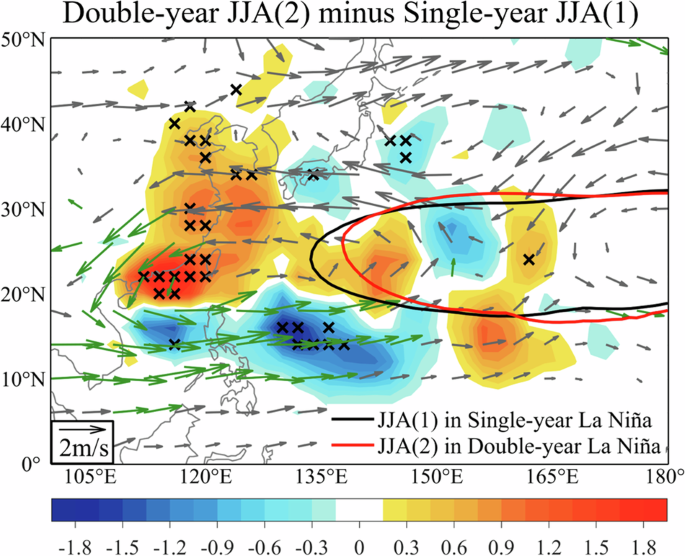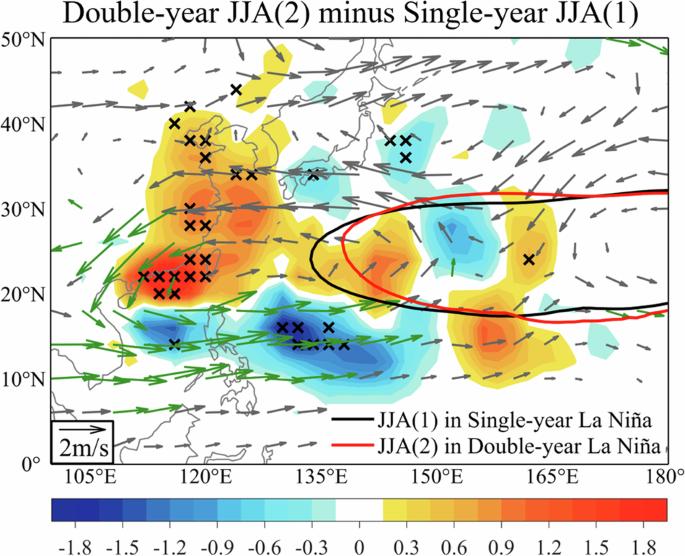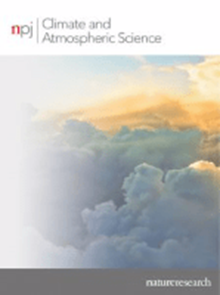在双年拉尼娜现象的第二个衰减夏季,中国沿海面临更多热带气旋风险
IF 8.5
1区 地球科学
Q1 METEOROLOGY & ATMOSPHERIC SCIENCES
引用次数: 0
摘要
近年来,持续时间较长的拉尼娜现象(包括两年期和三年期拉尼娜现象)越来越频繁。多年拉尼娜现象如何影响北太平洋西部的热带气旋(TC)活动,以及它们与单年期拉尼娜现象是否有区别,目前尚不清楚。在这里,我们发现热带气旋在远北太平洋(FWNP,110°-150°E)上空更为活跃,导致中国沿海在双年拉尼娜事件的第二个衰减夏季出现明显的高风险。热带气旋活动异常与远西北太平洋气旋异常增强直接相关,可能是热带北大西洋(TNA)降温引发的大尺度遥强迫的结果。从双年拉尼娜事件的冬季到夏季的衰减过程中,热带北大西洋持续变冷,通过开尔文波驱动印度-西太平洋上空的西风,通过风-蒸发-海面温度效应引起北印度洋变冷,有利于热量的非对称分布模式,并刺激东印度洋至西北太平洋上空的异常垂直环流。北印度洋的降温也激发了吉尔反应,放大了 TNA 诱导的西风,促进了异常垂直环流,从而导致夏季在 FWNP 上出现强烈的气旋环流异常。我们认为,这一过程的关键点在于,在双年拉尼娜事件衰减的同时,与持续的负太平洋-北美模式(PNA)和正北大西洋涛动(NAO)相关的强TNA冷却,有别于单年拉尼娜事件期间PNA和NAO的快速衰减。这项工作为了解与厄尔尼诺-南方涛动有关的热带气旋活动提供了一个独特的视角。本文章由计算机程序翻译,如有差异,请以英文原文为准。


China coasts facing more tropical cyclone risks during the second decaying summer of double-year La Niña events
Long-lasting La Niña events (including double-year and triple-year La Niña events) have become more frequent in recent years. How the multi-year La Niña events affect tropical cyclone (TC) activities in the western North Pacific (WNP) and whether they differ from single-year La Niña events are unknown. Here we show that TCs are more active over the far-WNP (FWNP, 110°–150°E), leading to marked high risks at China coasts during the second decaying summer of double-year La Niña events. The anomalous TC activities are directly related to the enhanced cyclonic anomaly over the FWNP, possibly a result of large-scale remote forcing initiated by the tropical North Atlantic (TNA) cooling. The persistent TNA cooling from the decaying winter to summer of double-year La Niña events drives westerlies over the Indo-western Pacific through Kelvin waves, which induce the cooling over the north Indian Ocean via the wind-evaporation-sea surface temperature effect, favoring the asymmetric heat distribution pattern and stimulating an anomalous vertical circulation over the eastern Indian Ocean to FWNP. The cooling over the north Indian Ocean also excites Gill responses, magnifying the TNA-induced westerlies and boosting the anomalous vertical circulation, and thus gives rise to the strong cyclonic circulation anomaly over the FWNP in summer. We suggest that the key point of the process is the strong TNA cooling related to the persistent negative Pacific-North American pattern (PNA) and positive North Atlantic Oscillation (NAO) while double-year La Niña events decay, distinct from the rapid decline of PNA and NAO during single-year La Niña events. The work provides a unique perspective on understanding TC activities over the WNP related to the El Niño-Southern Oscillation.
求助全文
通过发布文献求助,成功后即可免费获取论文全文。
去求助
来源期刊

npj Climate and Atmospheric Science
Earth and Planetary Sciences-Atmospheric Science
CiteScore
8.80
自引率
3.30%
发文量
87
审稿时长
21 weeks
期刊介绍:
npj Climate and Atmospheric Science is an open-access journal encompassing the relevant physical, chemical, and biological aspects of atmospheric and climate science. The journal places particular emphasis on regional studies that unveil new insights into specific localities, including examinations of local atmospheric composition, such as aerosols.
The range of topics covered by the journal includes climate dynamics, climate variability, weather and climate prediction, climate change, ocean dynamics, weather extremes, air pollution, atmospheric chemistry (including aerosols), the hydrological cycle, and atmosphere–ocean and atmosphere–land interactions. The journal welcomes studies employing a diverse array of methods, including numerical and statistical modeling, the development and application of in situ observational techniques, remote sensing, and the development or evaluation of new reanalyses.
 求助内容:
求助内容: 应助结果提醒方式:
应助结果提醒方式:


